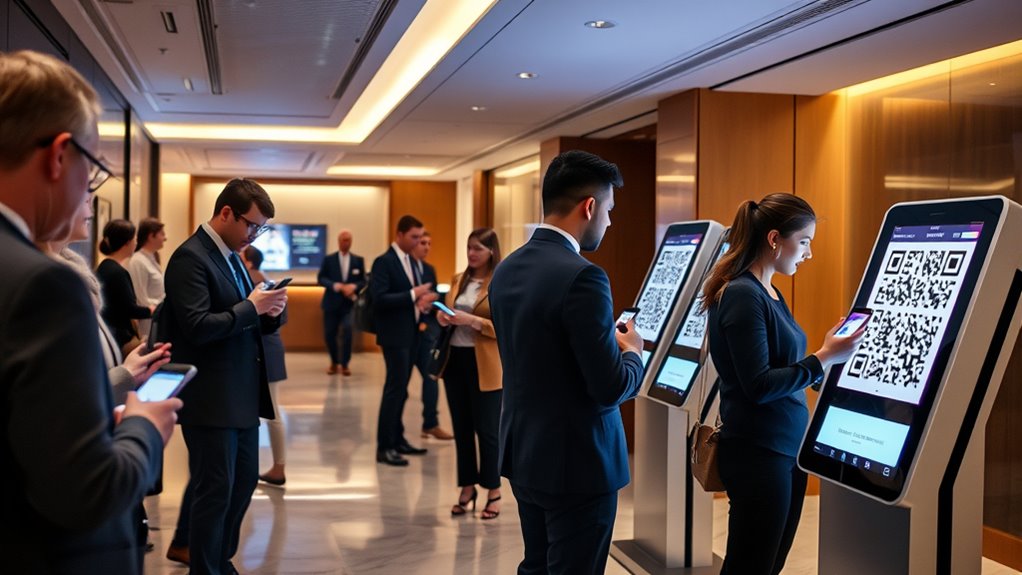Guests now prefer authentic, personalized interactions over relying heavily on QR codes and digital touchpoints. While digital tools make things quick and convenient, too many scans can lead to frustration and fatigue, showing signs like sighs or skipping codes. Instead, they value genuine human engagement—friendly greetings, personalized recommendations, and emotional connection. Balancing digital solutions with personal touches creates a more satisfying experience. If you want to learn how to meet these evolving preferences effectively, keep exploring the latest insights.
Key Takeaways
- Guests prefer quick, seamless digital interactions that minimize repetitive scanning or multiple QR code attempts.
- Many guests appreciate the availability of human assistance or face-to-face options alongside digital solutions.
- Personalized service and genuine human engagement help reduce fatigue and enhance overall experience.
- Clear, visually appealing digital touchpoints and instructions can prevent frustration and confusion.
- Offering alternative methods like NFC, QR code-free options, or direct staff support addresses fatigue concerns effectively.
Understanding the Rise of Digital Touchpoints in Hospitality

Have you noticed how digital touchpoints are transforming the hospitality industry? Today, guests expect seamless experiences powered by technology. From mobile check-ins to contactless payments, digital tools streamline interactions and reduce wait times. Hotels and restaurants integrate QR codes, apps, and kiosks to enhance convenience, catering to guests’ desire for quick, contactless service. This shift isn’t just about modernity; it’s driven by guests’ preferences for safety, speed, and personalization. As a result, staff can focus more on creating memorable experiences rather than managing manual processes. The rise of these digital touchpoints reflects a broader trend towards automation and connectivity, making hospitality more efficient and responsive. Incorporating projector technology into the guest experience can further elevate entertainment options and engagement. Understanding this evolution helps you adapt and meet evolving guest expectations effectively.
Recognizing Signs of QR‑Code Fatigue Among Guests

As digital touchpoints become more prevalent, guests can sometimes experience QR-code fatigue, which manifests when they grow frustrated or overwhelmed by frequent or repetitive scans. You might notice guests sighing loudly, glancing repeatedly at their phones, or showing signs of impatience. They may hesitate before scanning or skip QR codes altogether. Some guests could become visibly annoyed, sighing or rolling their eyes, indicating frustration. Others might ask staff for direct assistance or express dissatisfaction with the process. Pay attention to these cues, as they signal that your guests are overwhelmed. Recognizing these signs early allows you to adapt quickly, offering alternative solutions or streamlining the experience to reduce their frustration. Staying attentive helps ensure your guests feel valued and less overwhelmed, especially when considering the user experience of your digital engagement efforts.
Shift Toward Human-Centric Service and Personal Interactions

Customers crave genuine human interactions that make them feel valued. By focusing on personal touches and authentic engagement, you can elevate their overall experience. This shift helps rebuild trust and connection in an increasingly digital world. Incorporating personalized communication strategies can further deepen customer relationships.
Emphasis on Personal Touch
Despite the rise of QR codes and automated services, many people crave genuine human connections when seeking assistance. Personal touch matters more than ever, making your interactions memorable. When you see a friendly face or hear a warm voice, it builds trust and comfort. Here are four ways you can emphasize personal touch: 1. Greet guests with a smile and genuine interest. 2. Remember repeat visitors and their preferences. 3. Offer personalized recommendations based on individual needs. 4. Follow up to ensure satisfaction and show you care. Incorporating knowledge of essential oils for relaxation can also create a calming and personalized experience that resonates with guests.
Authentic Human Engagement
While technology offers convenience, authentic human engagement remains essential for meaningful connections. Guests crave genuine interactions that foster trust and comfort. Personal conversations, attentive service, and empathy create memorable experiences that digital tools can’t replicate. By prioritizing human touchpoints, you show guests they’re valued beyond transactions. This shift emphasizes active listening and emotional connection over automation alone. Consider the following:
| Human Interaction Focus | Benefits | Impact on Guest Satisfaction |
|---|---|---|
| Personalized Service | Builds loyalty | Enhances perceived value |
| Empathy & Care | Creates trust | Encourages repeat visits |
| Face-to-Face Contact | Strengthens bonds | Promotes positive reviews |
| Active Listening | Understands needs | Improves service delivery |
| Genuine Engagement | Fosters authenticity | Elevates overall experience |
Additionally, emphasizing ethical hacking principles can help ensure that digital interactions remain secure, protecting guest data and maintaining trust.
Elevated Guest Experiences
As technology streamlines many aspects of service, it’s easy to overlook the power of human-centric interactions in creating memorable guest experiences. Guests now crave genuine connections that make them feel valued and cared for. To elevate these experiences, consider focusing on:
- Personalized service that anticipates individual needs
- Warm, authentic conversations over automated exchanges
- Staff training to enhance empathy and emotional intelligence
- Creating welcoming environments that foster comfort and trust
Exploring Alternative Technologies for Guest Engagement

You can boost guest engagement by adopting digital touchpoints that offer seamless interactions. Contactless technologies, like mobile apps or NFC, provide a safer, more convenient experience. Exploring these options helps you stay ahead and meet guests’ evolving expectations. Incorporating innovative digital menu solutions can further enhance the dining experience and streamline operations.
Digital Touchpoints Boost Engagement
Digital touchpoints are transforming guest engagement by offering innovative alternatives to traditional methods like QR codes. These technologies make interactions smoother and more personalized, capturing guests’ attention and encouraging involvement. Instead of scanning a QR code, you can now engage through touchless kiosks, mobile apps, NFC tags, or virtual assistants. These options provide instant access to information, services, and entertainment, reducing frustration and enhancing satisfaction. For example, you might use your phone to check in, order room service, or get local recommendations without waiting in lines. These digital touchpoints create seamless experiences, making guests feel valued and understood. Embracing these alternatives helps you stand out and adapt to evolving preferences, fostering loyalty and positive reviews. Consistent use of innovative techniques like eye patches can also contribute to overall guest well-being and satisfaction.
Contactless Tech Enhances Experience
Building on the momentum of digital touchpoints, contactless technologies are revolutionizing guest interactions by offering even safer and more efficient ways to engage. Instead of relying solely on QR codes, you can incorporate options like NFC, mobile apps, and voice-activated systems. These alternatives streamline processes, reduce touchpoints, and improve overall convenience. Guests appreciate quick check-ins, contactless payments, and personalized experiences without physical contact. To visualize, consider this comparison:
| Technology | Key Benefit |
|---|---|
| NFC | Fast, tap-to-pay, quick access |
| Voice Assistants | Hands-free control, instant info |
| Mobile Apps | Customization, seamless booking |
| Contactless Payments | Safer, reduces physical exchange |
Additionally, integrating wall organization solutions can enhance the aesthetic appeal of a space while maintaining functionality. Adopting these options boosts safety, enhances guest satisfaction, and aligns with evolving preferences.
Designing Balance: Combining Digital and Personal Service Strategies

While technology offers efficiency and convenience, integrating personal service remains essential to creating a seamless customer experience. Striking the right balance helps guests feel valued without sacrificing speed. To do this:
- Use digital tools for quick check-ins and information sharing, reducing wait times.
- Train staff to recognize when guests prefer personal interaction and adapt accordingly.
- Incorporate human touches like personalized greetings or tailored recommendations.
- Offer options that let guests choose between digital and face-to-face services, respecting their preferences.
- Recognizing guest preferences can enhance satisfaction and loyalty.
Customizing Experiences to Meet Evolving Guest Expectations

As guest expectations continue to evolve, customizing experiences has become essential for staying ahead in the hospitality industry. You need to understand that today’s guests value personalized interactions that reflect their preferences and needs. Use data from previous stays, surveys, and real-time feedback to tailor services, room setups, and amenities. Offer options that cater to different lifestyles, such as wellness programs, local experiences, or tech preferences. Communicate proactively to show you’re listening and adaptable. When guests see that their unique preferences shape their stay, they feel more valued and engaged. This level of personalized service not only enhances satisfaction but also fosters loyalty, encouraging repeat visits and positive reviews. Meeting evolving expectations requires proactive efforts to create memorable, individualized experiences.
Implementing Feedback to Refine Digital Integration Efforts

Collecting and analyzing guest feedback is essential for refining your digital integration efforts. When you listen to your guests, you discover what works and what needs improvement. Use their insights to make targeted adjustments that enhance their experience.
Here’s how to effectively implement feedback:
- Prioritize recurring issues to address the most common frustrations first.
- Test small changes quickly to see their impact before larger rollouts.
- Involve staff in sharing guest comments to ensure consistent messaging.
- Regularly revisit feedback to track progress and adapt strategies as needed.
Frequently Asked Questions
How Can Hotels Effectively Re-Engage Guests After Qr‑Code Fatigue?
You can re-engage guests by offering personalized, human interactions alongside digital options. Instead of relying solely on QR codes, provide friendly staff to assist with check-ins, dining, and inquiries. Use technology thoughtfully—like mobile apps or chatbots—while ensuring there’s always a personable touch. Communicate clearly about new, convenient services, and create memorable experiences that make guests feel valued beyond just digital interfaces.
What Training Is Needed for Staff to Support Digital and Personal Service Integration?
To support digital and personal service integration, you need to train your staff in both technical skills and customer engagement. They should understand how to operate new digital tools confidently and seamlessly assist guests with tech-related questions. Additionally, focus on enhancing their interpersonal skills to ensure they can personalize interactions and provide warm, genuine service. Regular training sessions and role-playing exercises help your team stay adaptable and guest-focused.
Are There Demographic Differences in Qr‑Code Fatigue Levels Among Guests?
Imagine a hotel where younger guests embrace QR codes for menus, but older guests find them frustrating. Demographically, age plays a role in QR-code fatigue levels. Younger visitors often adapt quickly, while older guests may experience higher fatigue due to less familiarity with technology. Recognizing these differences helps you tailor services—offering both digital options and personal assistance guarantees a seamless experience for all guests.
How Can Hotels Measure the Success of Their Combined Digital and Human Interactions?
You can measure the success of your combined digital and human interactions by gathering guest feedback through surveys and monitoring satisfaction scores. Track engagement metrics like app usage and check-in times to see how smoothly technology complements human service. Observe guest behaviors and comments for insights. Regularly analyze these data points, adjusting your approach as needed to guarantee your guests feel valued and their experience remains seamless and personalized.
What Innovative Technologies Are Emerging to Reduce Qr‑Code Fatigue?
Sure, because who wouldn’t want more screens in their day? To cut down on QR-code fatigue, you can embrace innovative tech like voice-activated controls, augmented reality, or contactless NFC payments. These options let your guests skip the endless scanning and tap into a seamless, intuitive experience. By offering smarter, less tedious solutions, you make their stay easier and more enjoyable—without adding to their digital overload.
Conclusion
As you navigate the evolving hospitality landscape, remember that technology is a helpful guide, not a lighthouse that blinds. Balance the digital and personal like a finely tuned orchestra, ensuring each note resonates with your guests’ desires. By listening to their feedback and adapting your approach, you create a harmonious experience where technology enhances human connection, not replaces it. Ultimately, blending innovation with genuine care turns guest fatigue into loyalty’s sweet symphony.









